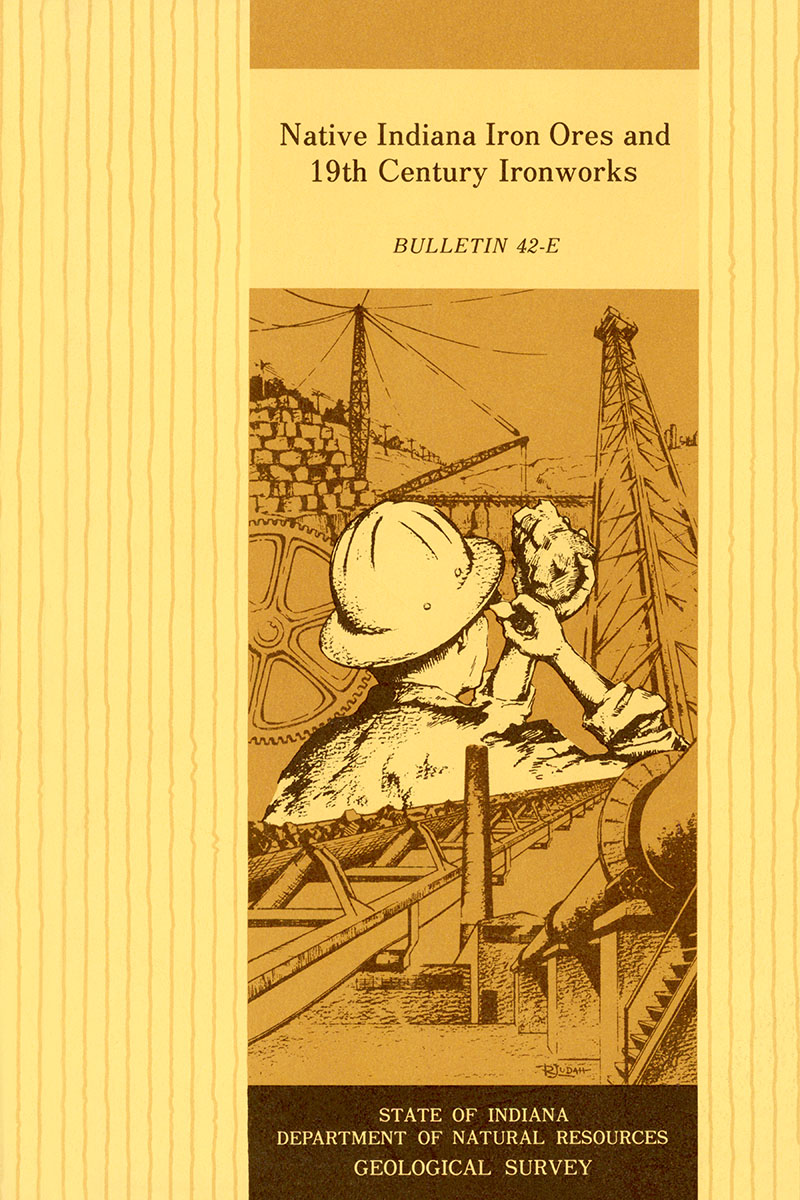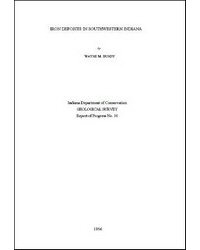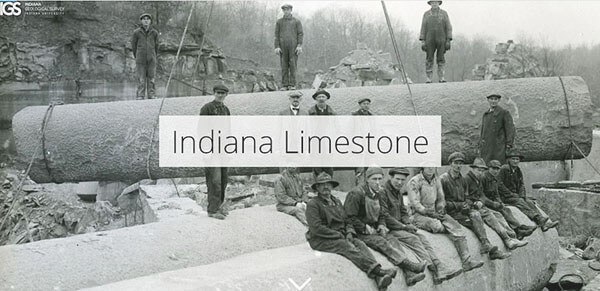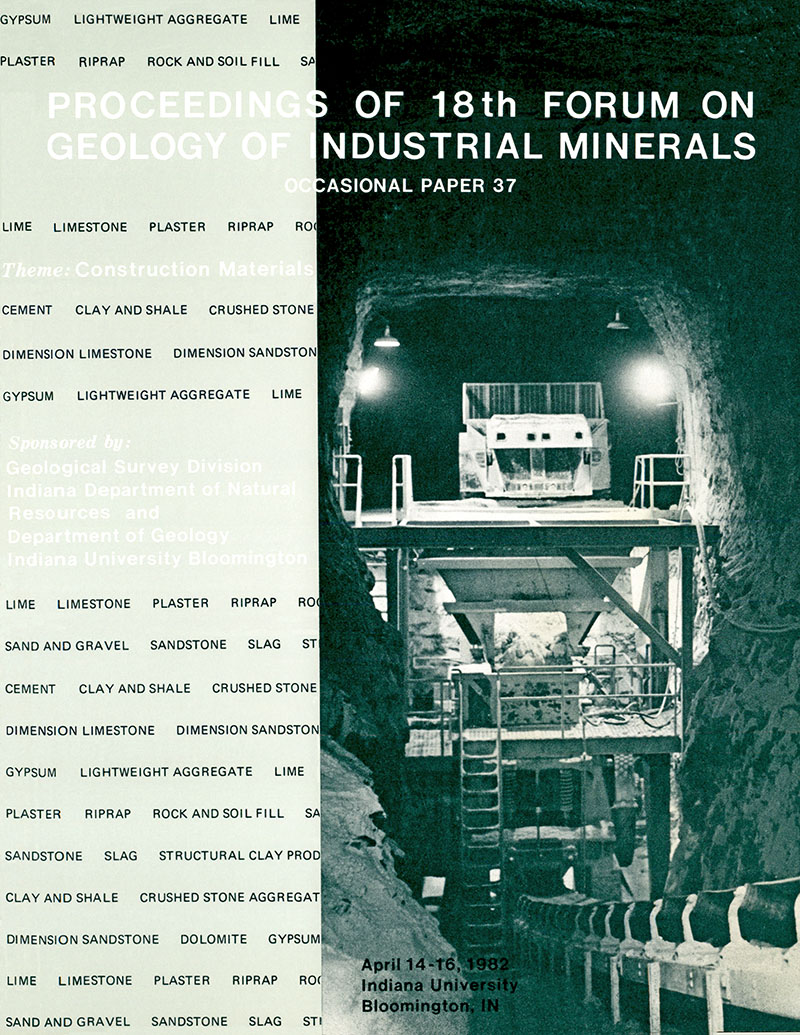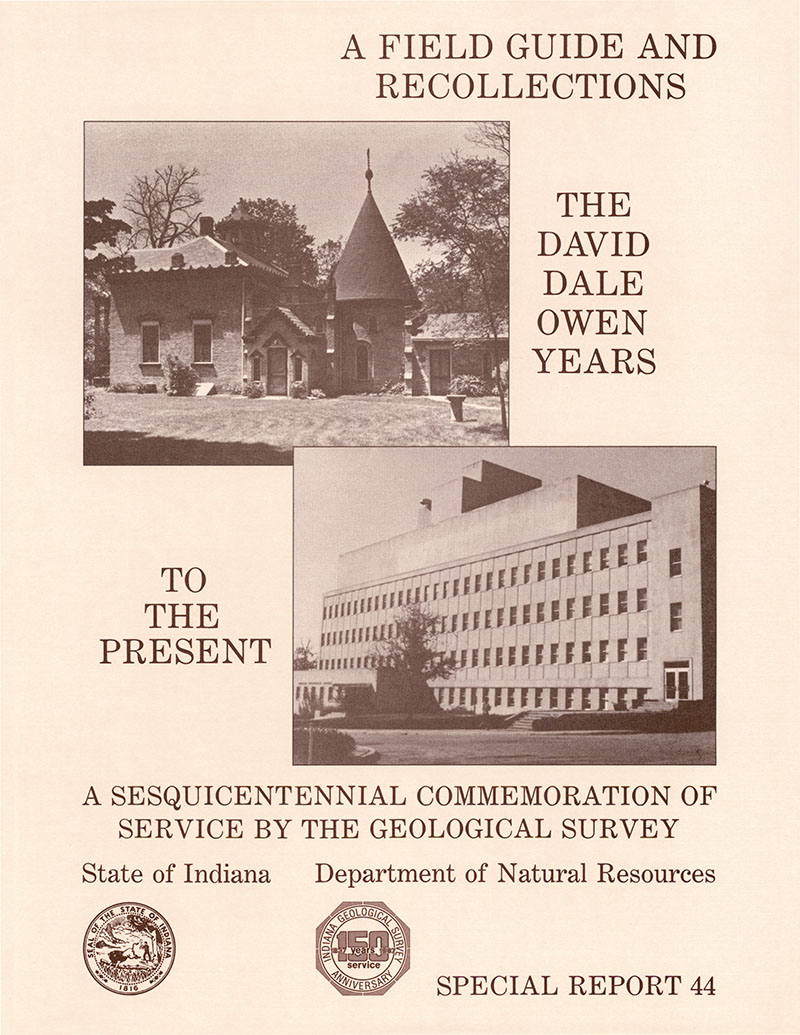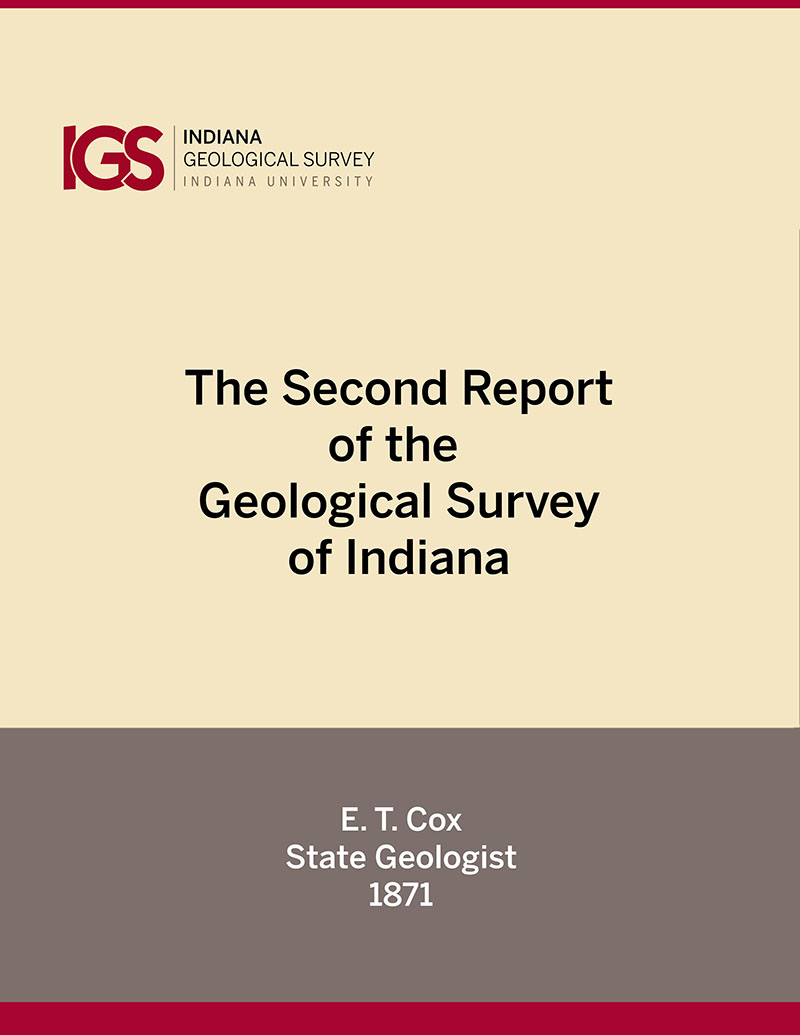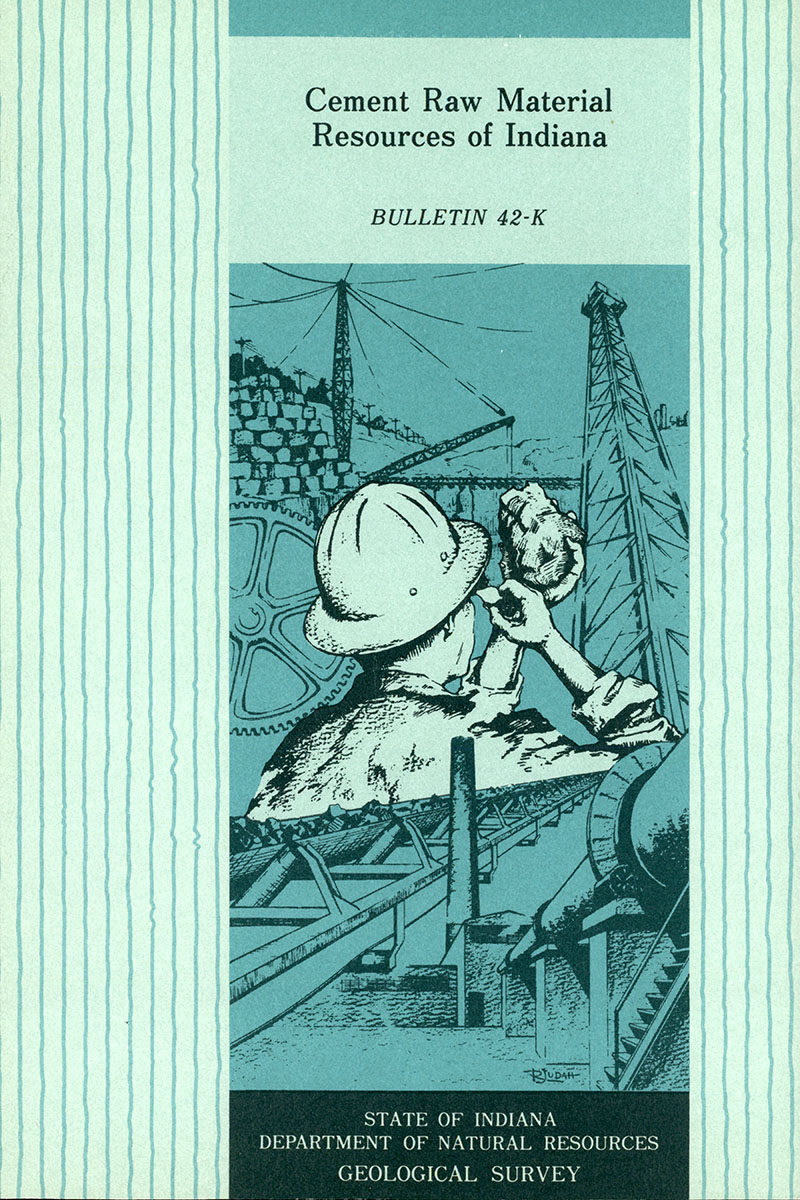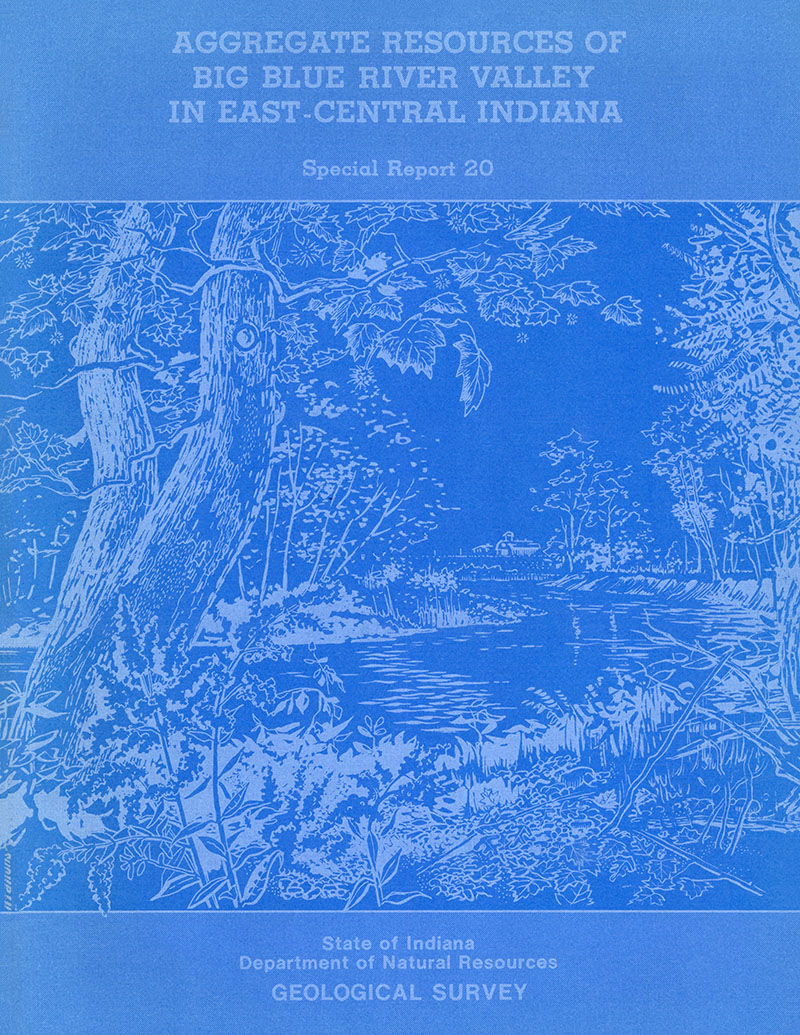INTRODUCTION: "The coming of iron manufacturers into the Indiana field should be encouraged. The reopening of ore deposits, the development of the coal fields, the building of furnaces within the state to smelt northern ores, the building of new railroads, and the extension of others, and the aggressive policy of existing roads to encourage industries along their lines, will undoubtedly make Indiana a great producer of iron and other products of commerce that will later be developed." So wrote C.W. Shannon in 1907, when Indiana was entering its third phase in the reduction of iron ore and in the manufacture of iron and steel. The U.S. Steel Corp. had recently purchased land at Indiana Harbor on Lake Michigan, and the new city of Gary was being laid out. Indiana was destined to become an iron- and steel- producing state again, and on a scale unheard of when the industry had its first start in the state. In the early part of the 19th century, farm implements and heavier household articles, such as kettles and stoves, were carried into the newly settled parts of Indiana by flatboat as far as the streams were navigable and then by wagon over trails that were difficult to travel even in good weather; therefore replacements for broken tools and utensils cost dearly. Early prospectors brought back to the East reports of abundant supplies or iron ore and plenty of timber to make charcoal. With these reports as a basis, several enterprising iron-workers set out for Indiana. Between 1835 and 1850 they built four blast furnaces and at least five Catalan forges (hearths for direct reduction of ore) to produce iron from the Indiana ores. After the Civil War several blast furnaces were designed to use Indiana Block coals. They reduced some local ore, but most of their ore was imported from Missouri." style="width:400px; height:120px;">INTRODUCTION: "The coming of iron manufacturers into the Indiana field should be encouraged. The reopening of ore deposits, the development of the coal fields, the building of furnaces within the state to smelt northern ores, the building of new railroads, and the extension of others, and the aggressive policy of existing roads to encourage industries along their lines, will undoubtedly make Indiana a great producer of iron and other products of commerce that will later be developed." So wrote C.W. Shannon in 1907, when Indiana was entering its third phase in the reduction of iron ore and in the manufacture of iron and steel. The U.S. Steel Corp. had recently purchased land at Indiana Harbor on Lake Michigan, and the new city of Gary was being laid out. Indiana was destined to become an iron- and steel- producing state again, and on a scale unheard of when the industry had its first start in the state. In the early part of the 19th century, farm implements and heavier household articles, such as kettles and stoves, were carried into the newly settled parts of Indiana by flatboat as far as the streams were navigable and then by wagon over trails that were difficult to travel even in good weather; therefore replacements for broken tools and utensils cost dearly. Early prospectors brought back to the East reports of abundant supplies or iron ore and plenty of timber to make charcoal. With these reports as a basis, several enterprising iron-workers set out for Indiana. Between 1835 and 1850 they built four blast furnaces and at least five Catalan forges (hearths for direct reduction of ore) to produce iron from the Indiana ores. After the Civil War several blast furnaces were designed to use Indiana Block coals. They reduced some local ore, but most of their ore was imported from Missouri." style="width:400px; height:120px;">th century, farm implements and heavier household articles, such as kettles and stoves, were carried into the newly settled parts of Indiana by flatboat as far as the streams were navigable and then by wagon over trails that were difficult to travel even in good weather; therefore replacements for broken tools and utensils cost dearly. Early prospectors brought back to the East reports of abundant supplies or iron ore and plenty of timber to make charcoal. With these reports as a basis, several enterprising iron-workers set out for Indiana. Between 1835 and 1850 they built four blast furnaces and at least five Catalan forges (hearths for direct reduction of ore) to produce iron from the Indiana ores. After the Civil War several blast furnaces were designed to use Indiana Block coals. They reduced some local ore, but most of their ore was imported from Missouri." style="width:400px; height:120px;">INTRODUCTION: "The coming of iron manufacturers into the Indiana field should be encouraged. The reopening of ore deposits, the development of the coal fields, the building of furnaces within the state to smelt northern ores, the building of new railroads, and the extension of others, and the aggressive policy of existing roads to encourage industries along their lines, will undoubtedly make Indiana a great producer of iron and other products of commerce that will later be developed." So wrote C.W. Shannon in 1907, when Indiana was entering its third phase in the reduction of iron ore and in the manufacture of iron and steel. The U.S. Steel Corp. had recently purchased land at Indiana Harbor on Lake Michigan, and the new city of Gary was being laid out. Indiana was destined to become an iron- and steel- producing state again, and on a scale unheard of when the industry had its first start in the state. In the early part of the 19th century, farm implements and heavier household articles, such as kettles and stoves, were carried into the newly settled parts of Indiana by flatboat as far as the streams were navigable and then by wagon over trails that were difficult to travel even in good weather; therefore replacements for broken tools and utensils cost dearly. Early prospectors brought back to the East reports of abundant supplies or iron ore and plenty of timber to make charcoal. With these reports as a basis, several enterprising iron-workers set out for Indiana. Between 1835 and 1850 they built four blast furnaces and at least five Catalan forges (hearths for direct reduction of ore) to produce iron from the Indiana ores. After the Civil War several blast furnaces were designed to use Indiana Block coals. They reduced some local ore, but most of their ore was imported from Missouri." style="width:400px; height:120px;">th century, farm implements and heavier household articles, such as kettles and stoves, were carried into the newly settled parts of Indiana by flatboat as far as the streams were navigable and then by wagon over trails that were difficult to travel even in good weather; therefore replacements for broken tools and utensils cost dearly. Early prospectors brought back to the East reports of abundant supplies or iron ore and plenty of timber to make charcoal. With these reports as a basis, several enterprising iron-workers set out for Indiana. Between 1835 and 1850 they built four blast furnaces and at least five Catalan forges (hearths for direct reduction of ore) to produce iron from the Indiana ores. After the Civil War several blast furnaces were designed to use Indiana Block coals. They reduced some local ore, but most of their ore was imported from Missouri." style="width:400px; height:120px;">th century, farm implements and heavier household articles, such as kettles and stoves, were carried into the newly settled parts of Indiana by flatboat as far as the streams were navigable and then by wagon over trails that were difficult to travel even in good weather; therefore replacements for broken tools and utensils cost dearly. Early prospectors brought back to the East reports of abundant supplies or iron ore and plenty of timber to make charcoal. With these reports as a basis, several enterprising iron-workers set out for Indiana. Between 1835 and 1850 they built four blast furnaces and at least five Catalan forges (hearths for direct reduction of ore) to produce iron from the Indiana ores. After the Civil War several blast furnaces were designed to use Indiana Block coals. They reduced some local ore, but most of their ore was imported from Missouri." style="width:400px; height:120px;">INTRODUCTION: "The coming of iron manufacturers into the Indiana field should be encouraged. The reopening of ore deposits, the development of the coal fields, the building of furnaces within the state to smelt northern ores, the building of new railroads, and the extension of others, and the aggressive policy of existing roads to encourage industries along their lines, will undoubtedly make Indiana a great producer of iron and other products of commerce that will later be developed." So wrote C.W. Shannon in 1907, when Indiana was entering its third phase in the reduction of iron ore and in the manufacture of iron and steel. The U.S. Steel Corp. had recently purchased land at Indiana Harbor on Lake Michigan, and the new city of Gary was being laid out. Indiana was destined to become an iron- and steel- producing state again, and on a scale unheard of when the industry had its first start in the state. In the early part of the 19th century, farm implements and heavier household articles, such as kettles and stoves, were carried into the newly settled parts of Indiana by flatboat as far as the streams were navigable and then by wagon over trails that were difficult to travel even in good weather; therefore replacements for broken tools and utensils cost dearly. Early prospectors brought back to the East reports of abundant supplies or iron ore and plenty of timber to make charcoal. With these reports as a basis, several enterprising iron-workers set out for Indiana. Between 1835 and 1850 they built four blast furnaces and at least five Catalan forges (hearths for direct reduction of ore) to produce iron from the Indiana ores. After the Civil War several blast furnaces were designed to use Indiana Block coals. They reduced some local ore, but most of their ore was imported from Missouri." style="width:400px; height:120px;">INTRODUCTION: "The coming of iron manufacturers into the Indiana field should be encouraged. The reopening of ore deposits, the development of the coal fields, the building of furnaces within the state to smelt northern ores, the building of new railroads, and the extension of others, and the aggressive policy of existing roads to encourage industries along their lines, will undoubtedly make Indiana a great producer of iron and other products of commerce that will later be developed." So wrote C.W. Shannon in 1907, when Indiana was entering its third phase in the reduction of iron ore and in the manufacture of iron and steel. The U.S. Steel Corp. had recently purchased land at Indiana Harbor on Lake Michigan, and the new city of Gary was being laid out. Indiana was destined to become an iron- and steel- producing state again, and on a scale unheard of when the industry had its first start in the state. In the early part of the 19th century, farm implements and heavier household articles, such as kettles and stoves, were carried into the newly settled parts of Indiana by flatboat as far as the streams were navigable and then by wagon over trails that were difficult to travel even in good weather; therefore replacements for broken tools and utensils cost dearly. Early prospectors brought back to the East reports of abundant supplies or iron ore and plenty of timber to make charcoal. With these reports as a basis, several enterprising iron-workers set out for Indiana. Between 1835 and 1850 they built four blast furnaces and at least five Catalan forges (hearths for direct reduction of ore) to produce iron from the Indiana ores. After the Civil War several blast furnaces were designed to use Indiana Block coals. They reduced some local ore, but most of their ore was imported from Missouri." style="width:400px; height:120px;">th century, farm implements and heavier household articles, such as kettles and stoves, were carried into the newly settled parts of Indiana by flatboat as far as the streams were navigable and then by wagon over trails that were difficult to travel even in good weather; therefore replacements for broken tools and utensils cost dearly. Early prospectors brought back to the East reports of abundant supplies or iron ore and plenty of timber to make charcoal. With these reports as a basis, several enterprising iron-workers set out for Indiana. Between 1835 and 1850 they built four blast furnaces and at least five Catalan forges (hearths for direct reduction of ore) to produce iron from the Indiana ores. After the Civil War several blast furnaces were designed to use Indiana Block coals. They reduced some local ore, but most of their ore was imported from Missouri." style="width:400px; height:120px;">INTRODUCTION: "The coming of iron manufacturers into the Indiana field should be encouraged. The reopening of ore deposits, the development of the coal fields, the building of furnaces within the state to smelt northern ores, the building of new railroads, and the extension of others, and the aggressive policy of existing roads to encourage industries along their lines, will undoubtedly make Indiana a great producer of iron and other products of commerce that will later be developed." So wrote C.W. Shannon in 1907, when Indiana was entering its third phase in the reduction of iron ore and in the manufacture of iron and steel. The U.S. Steel Corp. had recently purchased land at Indiana Harbor on Lake Michigan, and the new city of Gary was being laid out. Indiana was destined to become an iron- and steel- producing state again, and on a scale unheard of when the industry had its first start in the state. In the early part of the 19th century, farm implements and heavier household articles, such as kettles and stoves, were carried into the newly settled parts of Indiana by flatboat as far as the streams were navigable and then by wagon over trails that were difficult to travel even in good weather; therefore replacements for broken tools and utensils cost dearly. Early prospectors brought back to the East reports of abundant supplies or iron ore and plenty of timber to make charcoal. With these reports as a basis, several enterprising iron-workers set out for Indiana. Between 1835 and 1850 they built four blast furnaces and at least five Catalan forges (hearths for direct reduction of ore) to produce iron from the Indiana ores. After the Civil War several blast furnaces were designed to use Indiana Block coals. They reduced some local ore, but most of their ore was imported from Missouri." style="width:400px; height:120px;">th century, farm implements and heavier household articles, such as kettles and stoves, were carried into the newly settled parts of Indiana by flatboat as far as the streams were navigable and then by wagon over trails that were difficult to travel even in good weather; therefore replacements for broken tools and utensils cost dearly. Early prospectors brought back to the East reports of abundant supplies or iron ore and plenty of timber to make charcoal. With these reports as a basis, several enterprising iron-workers set out for Indiana. Between 1835 and 1850 they built four blast furnaces and at least five Catalan forges (hearths for direct reduction of ore) to produce iron from the Indiana ores. After the Civil War several blast furnaces were designed to use Indiana Block coals. They reduced some local ore, but most of their ore was imported from Missouri." style="width:400px; height:120px;">INTRODUCTION: "The coming of iron manufacturers into the Indiana field should be encouraged. The reopening of ore deposits, the development of the coal fields, the building of furnaces within the state to smelt northern ores, the building of new railroads, and the extension of others, and the aggressive policy of existing roads to encourage industries along their lines, will undoubtedly make Indiana a great producer of iron and other products of commerce that will later be developed." So wrote C.W. Shannon in 1907, when Indiana was entering its third phase in the reduction of iron ore and in the manufacture of iron and steel. The U.S. Steel Corp. had recently purchased land at Indiana Harbor on Lake Michigan, and the new city of Gary was being laid out. Indiana was destined to become an iron- and steel- producing state again, and on a scale unheard of when the industry had its first start in the state. In the early part of the 19th century, farm implements and heavier household articles, such as kettles and stoves, were carried into the newly settled parts of Indiana by flatboat as far as the streams were navigable and then by wagon over trails that were difficult to travel even in good weather; therefore replacements for broken tools and utensils cost dearly. Early prospectors brought back to the East reports of abundant supplies or iron ore and plenty of timber to make charcoal. With these reports as a basis, several enterprising iron-workers set out for Indiana. Between 1835 and 1850 they built four blast furnaces and at least five Catalan forges (hearths for direct reduction of ore) to produce iron from the Indiana ores. After the Civil War several blast furnaces were designed to use Indiana Block coals. They reduced some local ore, but most of their ore was imported from Missouri." style="width:400px; height:120px;">INTRODUCTION: "The coming of iron manufacturers into the Indiana field should be encouraged. The reopening of ore deposits, the development of the coal fields, the building of furnaces within the state to smelt northern ores, the building of new railroads, and the extension of others, and the aggressive policy of existing roads to encourage industries along their lines, will undoubtedly make Indiana a great producer of iron and other products of commerce that will later be developed." So wrote C.W. Shannon in 1907, when Indiana was entering its third phase in the reduction of iron ore and in the manufacture of iron and steel. The U.S. Steel Corp. had recently purchased land at Indiana Harbor on Lake Michigan, and the new city of Gary was being laid out. Indiana was destined to become an iron- and steel- producing state again, and on a scale unheard of when the industry had its first start in the state. In the early part of the 19th century, farm implements and heavier household articles, such as kettles and stoves, were carried into the newly settled parts of Indiana by flatboat as far as the streams were navigable and then by wagon over trails that were difficult to travel even in good weather; therefore replacements for broken tools and utensils cost dearly. Early prospectors brought back to the East reports of abundant supplies or iron ore and plenty of timber to make charcoal. With these reports as a basis, several enterprising iron-workers set out for Indiana. Between 1835 and 1850 they built four blast furnaces and at least five Catalan forges (hearths for direct reduction of ore) to produce iron from the Indiana ores. After the Civil War several blast furnaces were designed to use Indiana Block coals. They reduced some local ore, but most of their ore was imported from Missouri." style="width:400px; height:120px;">th century, farm implements and heavier household articles, such as kettles and stoves, were carried into the newly settled parts of Indiana by flatboat as far as the streams were navigable and then by wagon over trails that were difficult to travel even in good weather; therefore replacements for broken tools and utensils cost dearly. Early prospectors brought back to the East reports of abundant supplies or iron ore and plenty of timber to make charcoal. With these reports as a basis, several enterprising iron-workers set out for Indiana. Between 1835 and 1850 they built four blast furnaces and at least five Catalan forges (hearths for direct reduction of ore) to produce iron from the Indiana ores. After the Civil War several blast furnaces were designed to use Indiana Block coals. They reduced some local ore, but most of their ore was imported from Missouri." style="width:400px; height:120px;">INTRODUCTION: "The coming of iron manufacturers into the Indiana field should be encouraged. The reopening of ore deposits, the development of the coal fields, the building of furnaces within the state to smelt northern ores, the building of new railroads, and the extension of others, and the aggressive policy of existing roads to encourage industries along their lines, will undoubtedly make Indiana a great producer of iron and other products of commerce that will later be developed." So wrote C.W. Shannon in 1907, when Indiana was entering its third phase in the reduction of iron ore and in the manufacture of iron and steel. The U.S. Steel Corp. had recently purchased land at Indiana Harbor on Lake Michigan, and the new city of Gary was being laid out. Indiana was destined to become an iron- and steel- producing state again, and on a scale unheard of when the industry had its first start in the state. In the early part of the 19th century, farm implements and heavier household articles, such as kettles and stoves, were carried into the newly settled parts of Indiana by flatboat as far as the streams were navigable and then by wagon over trails that were difficult to travel even in good weather; therefore replacements for broken tools and utensils cost dearly. Early prospectors brought back to the East reports of abundant supplies or iron ore and plenty of timber to make charcoal. With these reports as a basis, several enterprising iron-workers set out for Indiana. Between 1835 and 1850 they built four blast furnaces and at least five Catalan forges (hearths for direct reduction of ore) to produce iron from the Indiana ores. After the Civil War several blast furnaces were designed to use Indiana Block coals. They reduced some local ore, but most of their ore was imported from Missouri." style="width:400px; height:120px;">th century, farm implements and heavier household articles, such as kettles and stoves, were carried into the newly settled parts of Indiana by flatboat as far as the streams were navigable and then by wagon over trails that were difficult to travel even in good weather; therefore replacements for broken tools and utensils cost dearly. Early prospectors brought back to the East reports of abundant supplies or iron ore and plenty of timber to make charcoal. With these reports as a basis, several enterprising iron-workers set out for Indiana. Between 1835 and 1850 they built four blast furnaces and at least five Catalan forges (hearths for direct reduction of ore) to produce iron from the Indiana ores. After the Civil War several blast furnaces were designed to use Indiana Block coals. They reduced some local ore, but most of their ore was imported from Missouri." style="width:400px; height:120px;">th century, farm implements and heavier household articles, such as kettles and stoves, were carried into the newly settled parts of Indiana by flatboat as far as the streams were navigable and then by wagon over trails that were difficult to travel even in good weather; therefore replacements for broken tools and utensils cost dearly. Early prospectors brought back to the East reports of abundant supplies or iron ore and plenty of timber to make charcoal. With these reports as a basis, several enterprising iron-workers set out for Indiana. Between 1835 and 1850 they built four blast furnaces and at least five Catalan forges (hearths for direct reduction of ore) to produce iron from the Indiana ores. After the Civil War several blast furnaces were designed to use Indiana Block coals. They reduced some local ore, but most of their ore was imported from Missouri." style="width:400px; height:120px;">INTRODUCTION: "The coming of iron manufacturers into the Indiana field should be encouraged. The reopening of ore deposits, the development of the coal fields, the building of furnaces within the state to smelt northern ores, the building of new railroads, and the extension of others, and the aggressive policy of existing roads to encourage industries along their lines, will undoubtedly make Indiana a great producer of iron and other products of commerce that will later be developed." So wrote C.W. Shannon in 1907, when Indiana was entering its third phase in the reduction of iron ore and in the manufacture of iron and steel. The U.S. Steel Corp. had recently purchased land at Indiana Harbor on Lake Michigan, and the new city of Gary was being laid out. Indiana was destined to become an iron- and steel- producing state again, and on a scale unheard of when the industry had its first start in the state. In the early part of the 19th century, farm implements and heavier household articles, such as kettles and stoves, were carried into the newly settled parts of Indiana by flatboat as far as the streams were navigable and then by wagon over trails that were difficult to travel even in good weather; therefore replacements for broken tools and utensils cost dearly. Early prospectors brought back to the East reports of abundant supplies or iron ore and plenty of timber to make charcoal. With these reports as a basis, several enterprising iron-workers set out for Indiana. Between 1835 and 1850 they built four blast furnaces and at least five Catalan forges (hearths for direct reduction of ore) to produce iron from the Indiana ores. After the Civil War several blast furnaces were designed to use Indiana Block coals. They reduced some local ore, but most of their ore was imported from Missouri." style="width:400px; height:120px;">INTRODUCTION: "The coming of iron manufacturers into the Indiana field should be encouraged. The reopening of ore deposits, the development of the coal fields, the building of furnaces within the state to smelt northern ores, the building of new railroads, and the extension of others, and the aggressive policy of existing roads to encourage industries along their lines, will undoubtedly make Indiana a great producer of iron and other products of commerce that will later be developed." So wrote C.W. Shannon in 1907, when Indiana was entering its third phase in the reduction of iron ore and in the manufacture of iron and steel. The U.S. Steel Corp. had recently purchased land at Indiana Harbor on Lake Michigan, and the new city of Gary was being laid out. Indiana was destined to become an iron- and steel- producing state again, and on a scale unheard of when the industry had its first start in the state. In the early part of the 19th century, farm implements and heavier household articles, such as kettles and stoves, were carried into the newly settled parts of Indiana by flatboat as far as the streams were navigable and then by wagon over trails that were difficult to travel even in good weather; therefore replacements for broken tools and utensils cost dearly. Early prospectors brought back to the East reports of abundant supplies or iron ore and plenty of timber to make charcoal. With these reports as a basis, several enterprising iron-workers set out for Indiana. Between 1835 and 1850 they built four blast furnaces and at least five Catalan forges (hearths for direct reduction of ore) to produce iron from the Indiana ores. After the Civil War several blast furnaces were designed to use Indiana Block coals. They reduced some local ore, but most of their ore was imported from Missouri." style="width:400px; height:120px;">th century, farm implements and heavier household articles, such as kettles and stoves, were carried into the newly settled parts of Indiana by flatboat as far as the streams were navigable and then by wagon over trails that were difficult to travel even in good weather; therefore replacements for broken tools and utensils cost dearly. Early prospectors brought back to the East reports of abundant supplies or iron ore and plenty of timber to make charcoal. With these reports as a basis, several enterprising iron-workers set out for Indiana. Between 1835 and 1850 they built four blast furnaces and at least five Catalan forges (hearths for direct reduction of ore) to produce iron from the Indiana ores. After the Civil War several blast furnaces were designed to use Indiana Block coals. They reduced some local ore, but most of their ore was imported from Missouri." style="width:400px; height:120px;">INTRODUCTION: "The coming of iron manufacturers into the Indiana field should be encouraged. The reopening of ore deposits, the development of the coal fields, the building of furnaces within the state to smelt northern ores, the building of new railroads, and the extension of others, and the aggressive policy of existing roads to encourage industries along their lines, will undoubtedly make Indiana a great producer of iron and other products of commerce that will later be developed." So wrote C.W. Shannon in 1907, when Indiana was entering its third phase in the reduction of iron ore and in the manufacture of iron and steel. The U.S. Steel Corp. had recently purchased land at Indiana Harbor on Lake Michigan, and the new city of Gary was being laid out. Indiana was destined to become an iron- and steel- producing state again, and on a scale unheard of when the industry had its first start in the state. In the early part of the 19th century, farm implements and heavier household articles, such as kettles and stoves, were carried into the newly settled parts of Indiana by flatboat as far as the streams were navigable and then by wagon over trails that were difficult to travel even in good weather; therefore replacements for broken tools and utensils cost dearly. Early prospectors brought back to the East reports of abundant supplies or iron ore and plenty of timber to make charcoal. With these reports as a basis, several enterprising iron-workers set out for Indiana. Between 1835 and 1850 they built four blast furnaces and at least five Catalan forges (hearths for direct reduction of ore) to produce iron from the Indiana ores. After the Civil War several blast furnaces were designed to use Indiana Block coals. They reduced some local ore, but most of their ore was imported from Missouri.
Wayne, W. J. 1970, Native Indiana iron ores and 19th Century ironworks: Indiana Geological Survey Bulletin 42E, 25 p., 10 fig.
You may also like:
Keywords: industrial minerals, history, iron
Can't find what you're looking for? Feel free to contact us directly:
Indiana Geological and Water Survey
1001 E. 10th St.
Bloomington, IN 47405
812-855-7636 (phone)
812-855-2862 (fax)
IGWSinfo@indiana.edu
IGS Return Policy
- Original sales receipt required.
- Returns accepted within 30 days of purchase date.
- Refund will be issued by the same method of payment as purchased.
- Products must be returned in the same new condition as purchased.
- Refunds on custom orders and digital products are NOT allowed.
- Customers are responsible for paying shipping costs to return products.
Updated 8/19/2020



